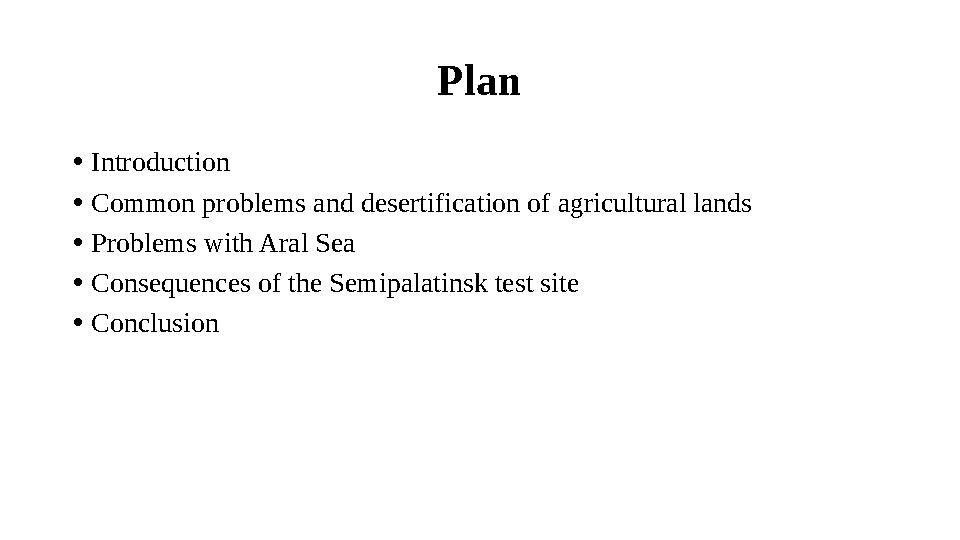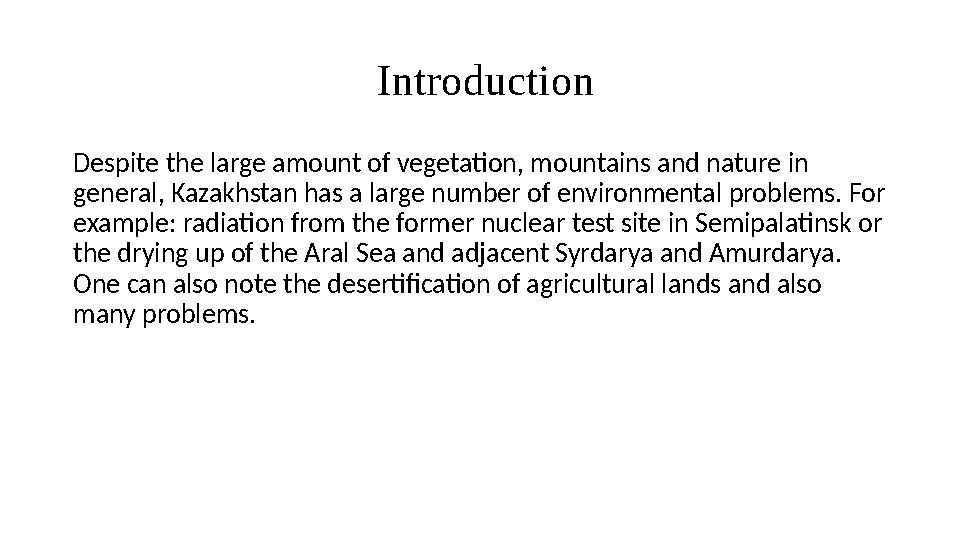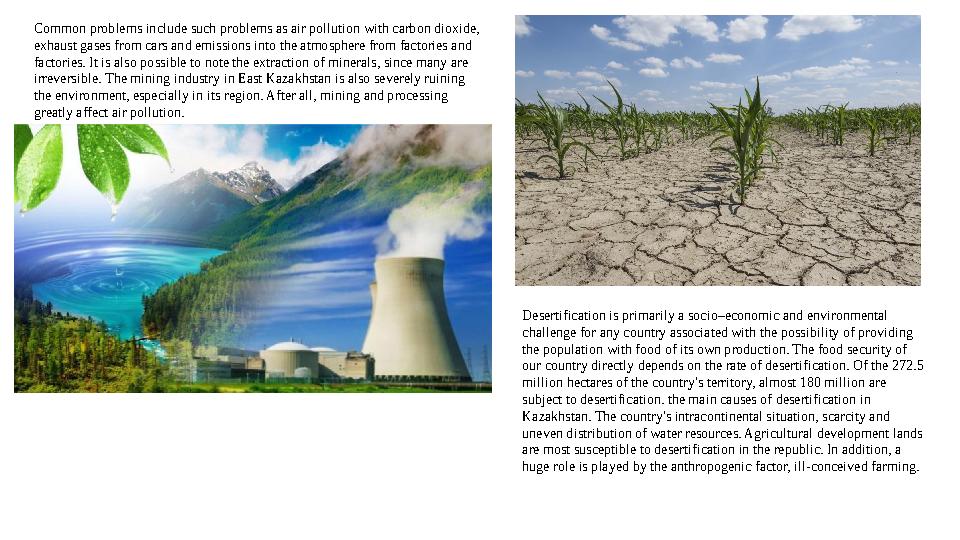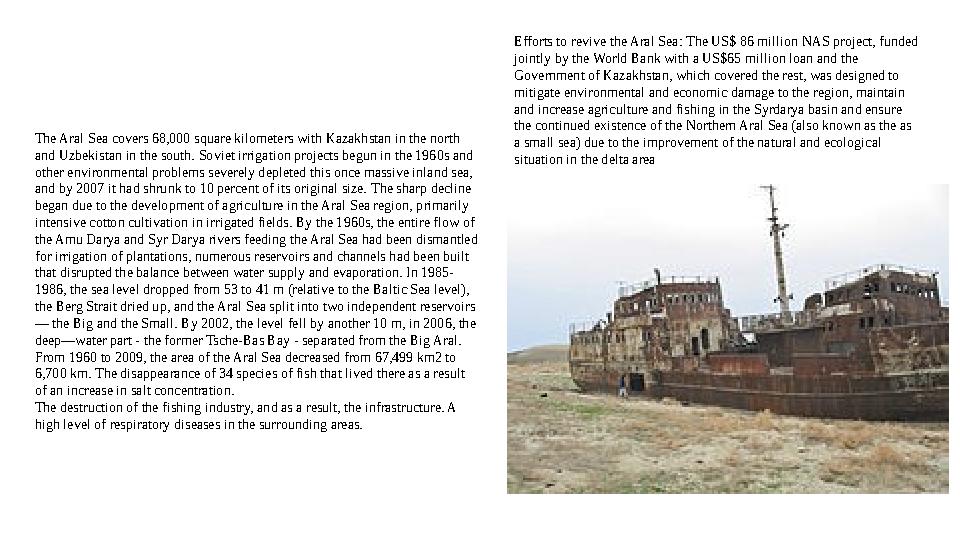Environmental problems of your country презентация
Environmental problems of your country презентация


#1 слайд
PRESENTATION
Theme: Environmental problems of your country
Prepared by:
Group:
Submitted to:
Shymkent 20 99
1 слайд
PRESENTATION Theme: Environmental problems of your country Prepared by: Group: Submitted to: Shymkent 20 99

#2 слайд
Plan
•
Introduction
•
Common problems and desertification of agricultural lands
•
Problems with Aral Sea
•
Consequences of the Semipalatinsk test site
•
Conclusion
2 слайд
Plan • Introduction • Common problems and desertification of agricultural lands • Problems with Aral Sea • Consequences of the Semipalatinsk test site • Conclusion

#3 слайд
Introduction
Despite the large amount of vegetation, mountains and nature in
general, Kazakhstan has a large number of environmental problems. For
example: radiation from the former nuclear test site in Semipalatinsk or
the drying up of the Aral Sea and adjacent Syrdarya and Amurdarya.
One can also note the desertification of agricultural lands and also
many problems.
3 слайд
Introduction Despite the large amount of vegetation, mountains and nature in general, Kazakhstan has a large number of environmental problems. For example: radiation from the former nuclear test site in Semipalatinsk or the drying up of the Aral Sea and adjacent Syrdarya and Amurdarya. One can also note the desertification of agricultural lands and also many problems.

#4 слайд
Common problems include such problems as air pollution with carbon dioxide,
exhaust gases from cars and emissions into the atmosphere from factories and
factories. It is also possible to note the extraction of minerals, since many are
irreversible. The mining industry in East Kazakhstan is also severely ruining
the environment, especially in its region. After all, mining and processing
greatly affect air pollution .
Desertification is primarily a socio–economic and environmental
challenge for any country associated with the possibility of providing
the population with food of its own production. The food security of
our country directly depends on the rate of desertification. Of the 272.5
million hectares of the country's territory, almost 180 million are
subject to desertification. the main causes of desertification in
Kazakhstan. The country's intracontinental situation, scarcity and
uneven distribution of water resources. Agricultural development lands
are most susceptible to desertification in the republic. In addition, a
huge role is played by the anthropogenic factor, ill-conceived farming.
4 слайд
Common problems include such problems as air pollution with carbon dioxide, exhaust gases from cars and emissions into the atmosphere from factories and factories. It is also possible to note the extraction of minerals, since many are irreversible. The mining industry in East Kazakhstan is also severely ruining the environment, especially in its region. After all, mining and processing greatly affect air pollution . Desertification is primarily a socio–economic and environmental challenge for any country associated with the possibility of providing the population with food of its own production. The food security of our country directly depends on the rate of desertification. Of the 272.5 million hectares of the country's territory, almost 180 million are subject to desertification. the main causes of desertification in Kazakhstan. The country's intracontinental situation, scarcity and uneven distribution of water resources. Agricultural development lands are most susceptible to desertification in the republic. In addition, a huge role is played by the anthropogenic factor, ill-conceived farming.

#5 слайд
The Aral Sea covers 68,000 square kilometers with Kazakhstan in the north
and Uzbekistan in the south. Soviet irrigation projects begun in the 1960s and
other environmental problems severely depleted this once massive inland sea,
and by 2007 it had shrunk to 10 percent of its original size. The sharp decline
began due to the development of agriculture in the Aral Sea region, primarily
intensive cotton cultivation in irrigated fields. By the 1960s, the entire flow of
the Amu Darya and Syr Darya rivers feeding the Aral Sea had been dismantled
for irrigation of plantations, numerous reservoirs and channels had been built
that disrupted the balance between water supply and evaporation. In 1985-
1986, the sea level dropped from 53 to 41 m (relative to the Baltic Sea level),
the Berg Strait dried up, and the Aral Sea split into two independent reservoirs
— the Big and the Small. By 2002, the level fell by another 10 m, in 2006, the
deep—water part - the former Tsche-Bas Bay - separated from the Big Aral.
From 1960 to 2009, the area of the Aral Sea decreased from 67,499 km2 to
6,700 km . The disappearance of 34 species of fish that lived there as a result
of an increase in salt concentration.
The destruction of the fishing industry, and as a result, the infrastructure. A
high level of respiratory diseases in the surrounding areas. Efforts to revive the Aral Sea : The US$ 86 million NAS project, funded
jointly by the World Bank with a US$65 million loan and the
Government of Kazakhstan, which covered the rest, was designed to
mitigate environmental and economic damage to the region, maintain
and increase agriculture and fishing in the Syrdarya basin and ensure
the continued existence of the Northern Aral Sea (also known as the as
a small sea) due to the improvement of the natural and ecological
situation in the delta area
5 слайд
The Aral Sea covers 68,000 square kilometers with Kazakhstan in the north and Uzbekistan in the south. Soviet irrigation projects begun in the 1960s and other environmental problems severely depleted this once massive inland sea, and by 2007 it had shrunk to 10 percent of its original size. The sharp decline began due to the development of agriculture in the Aral Sea region, primarily intensive cotton cultivation in irrigated fields. By the 1960s, the entire flow of the Amu Darya and Syr Darya rivers feeding the Aral Sea had been dismantled for irrigation of plantations, numerous reservoirs and channels had been built that disrupted the balance between water supply and evaporation. In 1985- 1986, the sea level dropped from 53 to 41 m (relative to the Baltic Sea level), the Berg Strait dried up, and the Aral Sea split into two independent reservoirs — the Big and the Small. By 2002, the level fell by another 10 m, in 2006, the deep—water part - the former Tsche-Bas Bay - separated from the Big Aral. From 1960 to 2009, the area of the Aral Sea decreased from 67,499 km2 to 6,700 km . The disappearance of 34 species of fish that lived there as a result of an increase in salt concentration. The destruction of the fishing industry, and as a result, the infrastructure. A high level of respiratory diseases in the surrounding areas. Efforts to revive the Aral Sea : The US$ 86 million NAS project, funded jointly by the World Bank with a US$65 million loan and the Government of Kazakhstan, which covered the rest, was designed to mitigate environmental and economic damage to the region, maintain and increase agriculture and fishing in the Syrdarya basin and ensure the continued existence of the Northern Aral Sea (also known as the as a small sea) due to the improvement of the natural and ecological situation in the delta area

#6 слайд
Semipalatinsk test site is the first and one of the largest nuclear test sites of the USSR,
also known as "SIYAP" — Semipalatinsk nuclear test site. About 500 nuclear tests were
carried out and at least 616 thermonuclear and nuclear devices were detonated at the first
and largest test site in Semipalatinsk from 1949 to 1991. The gas fraction of 169
underground tests and radioactive clouds of 55 air and ground explosions went beyond
the theater of nuclear operations. After the tests at the landfill, the ecology of Kazakhstan
suffered a severe blow and the echoes of that radiation can still be found now. The
incidence of children in these regions in 2002-2003 exceeded the national indicators by
1.21-1.25 times and amounted to 100 thousand. the child population in the East
Kazakhstan region is 107584 and 120479 in the Karaganda region - 90235 and 103846
in the Pavlodar region - 86602 and 103440 against the republican indicators for these
years 78315 and 87619, respectively. Lakes that are formed as a result of explosions have very strong
radioactivity . One of the main consequences of the landfill for the
environment is radioactive contamination. During the tests, huge
amounts of radioactive substances were released into the
atmosphere, which then settled on the ground and entered water
and soil resources. As a result, most of the area around the landfill
is contaminated with high levels of radiation. Radioactive
substances have a serious impact on wildlife, including plants,
animals and humans. Various diseases are possible, including
cancer, genetic mutations and decreased immunity. The
Government of Kazakhstan is taking measures to rehabilitate and
reduce the consequences of radiation contamination of the
Semipalatinsk landfill. However, restoring ecological balance will
take a lot of time and effort. The environmental consequences of
the Semipalatinsk test site will accompany Kazakhstan for a long
time, and their solution will require coordination with the
countries that conducted nuclear tests, as well as international
support.
6 слайд
Semipalatinsk test site is the first and one of the largest nuclear test sites of the USSR, also known as "SIYAP" — Semipalatinsk nuclear test site. About 500 nuclear tests were carried out and at least 616 thermonuclear and nuclear devices were detonated at the first and largest test site in Semipalatinsk from 1949 to 1991. The gas fraction of 169 underground tests and radioactive clouds of 55 air and ground explosions went beyond the theater of nuclear operations. After the tests at the landfill, the ecology of Kazakhstan suffered a severe blow and the echoes of that radiation can still be found now. The incidence of children in these regions in 2002-2003 exceeded the national indicators by 1.21-1.25 times and amounted to 100 thousand. the child population in the East Kazakhstan region is 107584 and 120479 in the Karaganda region - 90235 and 103846 in the Pavlodar region - 86602 and 103440 against the republican indicators for these years 78315 and 87619, respectively. Lakes that are formed as a result of explosions have very strong radioactivity . One of the main consequences of the landfill for the environment is radioactive contamination. During the tests, huge amounts of radioactive substances were released into the atmosphere, which then settled on the ground and entered water and soil resources. As a result, most of the area around the landfill is contaminated with high levels of radiation. Radioactive substances have a serious impact on wildlife, including plants, animals and humans. Various diseases are possible, including cancer, genetic mutations and decreased immunity. The Government of Kazakhstan is taking measures to rehabilitate and reduce the consequences of radiation contamination of the Semipalatinsk landfill. However, restoring ecological balance will take a lot of time and effort. The environmental consequences of the Semipalatinsk test site will accompany Kazakhstan for a long time, and their solution will require coordination with the countries that conducted nuclear tests, as well as international support.

#7 слайд
Conclusion
In conclusion, I want to say that many problems of Kazakhstan can be solved if we take them
seriously, for example: problems with garbage if they are quickly taken out and thrown into garbage
cans will be better, filters can be installed at many factories, etc. Even such solutions can cause a
chain reaction in the world, which will lead to an improvement in the global environment as a whole.
And such problems as the Aral Sea and the Semipalatinsk test site, their solution is a matter of time,
since the Aral Sea has already dried up and returned to its former state, we can only speed up the
process. And the radiation from Semipalatinsk is slowly disintegrating as on the territory of the
Chernobyl station.
7 слайд
Conclusion In conclusion, I want to say that many problems of Kazakhstan can be solved if we take them seriously, for example: problems with garbage if they are quickly taken out and thrown into garbage cans will be better, filters can be installed at many factories, etc. Even such solutions can cause a chain reaction in the world, which will lead to an improvement in the global environment as a whole. And such problems as the Aral Sea and the Semipalatinsk test site, their solution is a matter of time, since the Aral Sea has already dried up and returned to its former state, we can only speed up the process. And the radiation from Semipalatinsk is slowly disintegrating as on the territory of the Chernobyl station.

шағым қалдыра аласыз
















